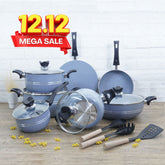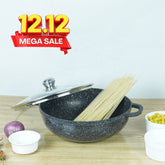🍚 How to Cook Rice Perfectly in a Pressure Cooker

No More Sticky, Mushy, or Burnt Rice!
If you’ve ever opened your pressure cooker hoping for fluffy rice — only to find a sticky, overcooked mess — you're not alone. Cooking rice in a pressure cooker can be tricky at first, but once you get the hang of it, it’s a total game-changer.
New to pressure cookers? Start with our full Pressure Cooker Buying Guide.
Whether you're making plain chawal, pulao, or prepping for biryani, this guide will help you cook rice perfectly every time, using tips that actually work in Pakistani kitchens.
🥣 Why Use a Pressure Cooker for Rice?
Let’s face it — no one wants to stand around watching the water boil. Pressure cookers:
-
Cut cooking time in half
-
Use less gas or electricity
-
Give you evenly cooked grains
-
Keep your kitchen cooler (especially in summer!)
And yes — they can make amazing rice, if you know the right water ratios and timing.
📏 Ideal Water-to-Rice Ratio (Desi Style)
| Type of Rice | Water Ratio | Notes |
|---|---|---|
| Basmati (plain) | 1 cup rice : 1.5 cups water | Rinse well before cooking |
| Brown rice | 1 cup : 2.5 cups | Takes longer to soften |
| For pulao or biryani | Varies (see below) | Adjust based on meat/veggies |
💡 Pro Tip:
Always rinse your rice 2–3 times to remove extra starch — this prevents it from becoming sticky.
✅ Step-by-Step: How to Cook Plain Rice in a Pressure Cooker
🔹 You’ll Need:
-
1 cup basmati rice (serves 2)
-
1.5 cups water
-
A pinch of salt (optional)
-
½ tsp ghee or oil (optional — prevents sticking)
🔹 Steps:
-
Rinse your rice 2–3 times and drain.
-
Add water, rice, salt, and ghee into the pressure cooker.
-
Close the lid tightly and place the weight/whistle.
-
Turn the flame on high and wait for 1 whistle.
-
Immediately turn off the heat.
-
Let the cooker sit unopened for 5–7 minutes.
-
Carefully release pressure if needed, and open the lid.
🥄 Fluff gently with a fork — you’ll have soft, separate grains.
🍛 How to Make Pulao in a Pressure Cooker
Cooking matar pulao or chicken pulao?
-
Sauté your onions, whole spices, and meat/veggies first.
-
Add soaked rice and measured water.
-
Pressure cook for 1 whistle, then let it rest for 8–10 minutes before opening.
Water Tip:
If adding meat, subtract the water already released by the meat when calculating your total ratio.
🧯 Avoid These Common Mistakes
-
❌ Too much water = sticky, soggy rice
-
❌ Too many whistles = broken, overcooked grains
-
❌ Forgetting to rest = rice sticks to bottom
-
❌ Unsoaked rice = uneven cooking (especially for pulao)
First time using a cooker? Here’s a step-by-step safety guide for beginners.
✅ Always soak rice for 15–20 minutes before pressure cooking.
🤔 FAQs – Real Questions from Pakistani Kitchens
Q: Can I cook rice and daal together in a pressure cooker?
Yes, but they cook at different speeds. Use a divider tray or cook rice separately for better results.
Q: Is 1 whistle enough?
Yes! For basmati chawal, 1 whistle and 5–7 minutes of rest gives perfect results. More than that, and the rice will break.
Q: My rice always sticks to the bottom — what should I do?
Try adding ½ tsp oil or ghee. Also make sure there’s enough water and don’t let it sit on heat after the whistle.
🛒 Best Klassic Cookers for Rice
| Model | Size | Perfect For | Price (PKR) |
|---|---|---|---|
| Klassic Classic – 5L | 5 Litres | Plain rice, 2–4 people | Rs. 6,999 |
| Klassic Ultima – 7L | 7 Litres | Pulao, chicken rice | Rs. 6,499 |
| Klassic Steamer – 9L | 9 Litres | Cook rice + steam at once | Rs. 7,999 |
👉 See All Klassic Pressure Cookers
👩🍳 Final Thoughts
Cooking rice in a pressure cooker might feel like a gamble the first time, but once you get the hang of it — there’s no going back. It’s fast, energy-saving, and gives you soft, fluffy rice in just minutes.
Just remember:
-
Use the right water ratio
-
Go easy on the whistles
-
Let it rest before opening
And you’ll never look at your old rice pot the same way again.








